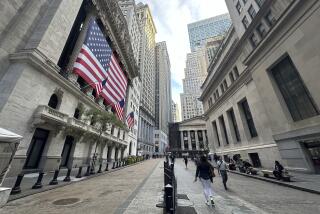Reports to Give Clues on Possible ‘Double Dip’
The barrage of economic reports due this week is likely to steal the spotlight as investors search for signs that the dreaded “double dip,” when the economy falls back into recession for a second time in quick succession, is at bay.
The head of an elite panel that decides U.S. business cycles said the recession may have ended as early as last November, but his group won’t formally declare it over until it rules out a renewed slump.
“We’re not ready to do that,” Robert Hall, chairman of the National Bureau of Economic Research’s Business Cycle Dating Committee, said at a meeting of business economists.
“A lot will depend on the [payroll] number that comes out on Friday. If it’s negative, that’s definitely going to cause us to pause,” Hall said. The Labor Department on Friday will report employment data for September. Economists surveyed by Reuters expect on average payrolls to have edged ahead by 5,000; the unemployment rate is seen rising to 5.9% from 5.7% in August.
The economists who make up the Business Cycle Dating Committee often wait many months before pegging peaks and troughs in the economy. The group, widely regarded as authoritative, held off until December 1992 to declare that March 1991 marked the end of the 1990-91 recession, for instance.
Hall said if payroll growth was very strong for two more months, then that might give the panel a basis for calling an end to the recession.
“November is probably the earliest date we’d pick and March is the latest date,” he said of the recession’s end, assuming the U.S. economy continues growing from here.
He said one cloud over the process is the as-yet-unanswered question of whether the U.S. economy might slip back into a renewed downturn.
If that happens, the panel would have to decide if such a renewed downturn would mark a separate recession or would be considered part of the contraction that began in March 2001.
Also this week, the Institute for Supply Management’s closely watched manufacturing sector report for September, due on Tuesday, is expected to show expansion, albeit sluggish, in the sector. The forecast: The index will rise to 50.8 in September from 50.5 in August.
Personal income and spending data, coming today, may offer clues to whether the American consumer, whose spending drives two-thirds of U.S. growth, will continue to underpin the economy. Data on construction spending, car sales and factory orders also will catch investors’ attention.
A separate report from the Commerce Department on Thursday may show factory orders fell 0.3% in August, the second decline in the last three months, after rising 4.7% in July.
As manufacturing slows, construction is slumping. Spending on all construction probably fell 0.2% in August, the fourth straight month without an increase, a Commerce Department report Tuesday is expected to show. The drop was probably led by declines in office and factory construction only partly offset by increases in spending on housing.
More to Read
Inside the business of entertainment
The Wide Shot brings you news, analysis and insights on everything from streaming wars to production — and what it all means for the future.
You may occasionally receive promotional content from the Los Angeles Times.









